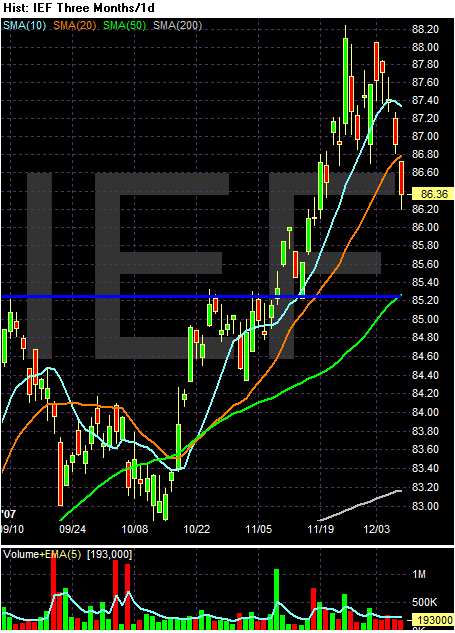For the week, the 10-year Treasury yield jumped to 4.11% from 3.94%. The two-year note, which moves on expectations about Fed policy, ended at 3.11%, up from 3.01%.
Here's a chart of the 7-10 year Treasury ETF:

Note that prices dropped below the 10 and 20 day simple moving average, which would be a strong sign that the overall upward moving trend is reversing.
So, why did the market sell-off last week? While the pundits were focusing on Friday's jobs report, I think the real underlying reason is the markets were simply looking to book profits. This ETF has risen over 10% since mid-June. As the end of the year approaches, look for traders to book end-of-the-year profits. I don't think it's anything more than that. Consider the following from the same Barron's article:
The same credit concerns that pushed Treasury yields to their lowest levels in more than two years pressured money-market rates higher. The one-month London interbank offered rate rose to 5.24% -- 74 basis points above the fed-funds rate target -- as banks were loath to lend to each other over the turn of the year. Three-month Libor rose to 5.14%. Usually, Libor tracks the funds rate closely, and these wide spreads indicate ongoing acute disquiet in the money markets.
Also consider this news:
UBS AG Monday said that two strategic foreign investors committed to inject capital worth 13 billion Swiss francs ($11.5 billion) as part of a broader move to strengthen capital as the Swiss bank announced a further $10 billion in write-downs on subprime holdings.
UBS, based in Zurich, also revised its outlook, saying it now expects to post a net loss attributable to shareholders in the fourth quarter, after having said earlier that it expects a profit overall. The bank said it was now possible that it will record a net loss for the full year.
The underlying reasons for the Treasury rally are still very much intact; the credit markets are still in bad shape and the writedowns related to the mortgage market continue.